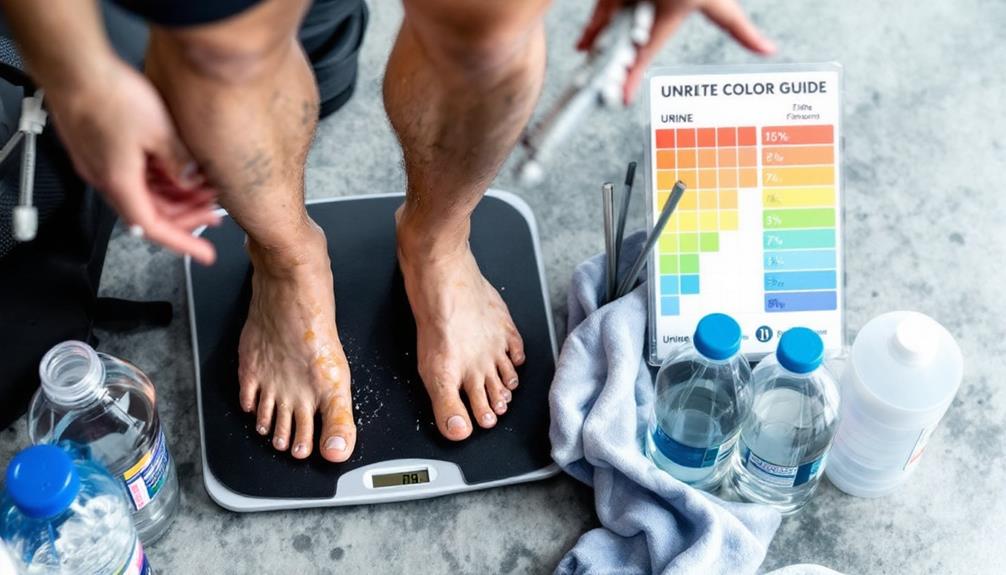To effectively cut weight as an athlete, focus on 10 essential strategies. Start with gradual weight reduction by losing 1-2 pounds weekly. Pay attention to hydration management—balance fluid intake and cut water before the weigh-in. Plan nutrient-dense meals with high-protein foods and healthy fats. Use strategic carbohydrate manipulation by reducing carbs leading up to the event. Monitor sodium and water balance to manage retention. Optimize sleep, reduce stress, and time your weight cut for peak performance. Finally, follow a solid post-weigh-in rehydration protocol to recover efficiently. Keep going to discover more useful tips.
Core Insight
- Gradually reduce calorie intake to create a sustainable weight loss plan, aiming for 1-2 pounds per week.
- Manage hydration by balancing fluid intake, gradually cutting back on water before weigh-in, and using electrolyte beverages.
- Focus on nutrient-dense meal planning, incorporating high-protein foods and healthy fats while controlling portion sizes.
- Manipulate carbohydrate intake strategically by reducing carbs leading up to the weigh-in and timing them around workouts for optimal performance.
- Implement a post-weigh-in rehydration protocol, starting with water and electrolyte drinks to restore lost fluids and minerals.
Gradual Weight Reduction

A gradual approach to weight loss is the safest and most effective way for athletes to reach their target weight. Start your weight loss journey well before your competition, aiming to lose 1-2 pounds each week. This slow pace helps you keep your muscle mass and maintain performance. Including high-quality protein sources, like grass-fed whey protein, can help you retain muscle during your weight loss, providing essential nutrients for recovery.
First, figure out how many calories you need each day, then create a small deficit of 300-500 calories. Focus on eating nutrient-rich foods to ensure your body gets what it needs. Increase your protein intake to support muscle retention, and add more fruits and vegetables for essential vitamins and minerals.
Pair your diet with a well-structured exercise routine that includes both strength training and cardio. This balanced approach will help you lose fat while keeping lean muscle. Remember to drink plenty of water and track your progress regularly, making adjustments as needed.
Hydration Management

Proper hydration management is key for athletes during weight cuts. You need to balance how much you drink with your weight loss goals. Here's a simple plan for staying hydrated while cutting weight:
- Check your urine color: Aim for a light yellow. This shows you are drinking enough fluids.
- Cut back on water gradually: Start drinking less water 2-3 days before your weigh-in.
- Drink electrolyte beverages: Mix in drinks with electrolytes to keep your minerals balanced. If it's really hot, you might want to use salt pills to help prevent dehydration.
- Rehydrate carefully after the weigh-in: Once you've made weight, slowly start drinking fluids again to avoid gaining weight too quickly.
Nutrient-Dense Meal Planning
Three important principles guide meal planning for athletes during weight cuts. First, focus on high-protein foods to keep your muscles strong. Include options like lean meats, fish, eggs, and plant-based proteins in your meals. Second, prioritize low-calorie, nutrient-rich vegetables. These will help you feel full while giving you important vitamins and minerals. Third, use complex carbohydrates in moderation to keep your energy levels steady. You might also consider adding beetroot powder supplements to your diet, as they can help improve endurance and boost nitric oxide production during workouts.
When planning your meals, start with a protein source as the base. Next, add a variety of colorful vegetables to your plate. Include small portions of whole grains or starchy vegetables for ongoing energy. Don't forget to add healthy fats from sources like avocados, nuts, and olive oil. These fats will help you feel satisfied and support your hormone function. Be sure to adjust portion sizes to fit your calorie needs during the weight cut.
Strategic Carbohydrate Manipulation

Strategic carbohydrate manipulation is key for athletes who are trying to lose weight. It's crucial to know how to adjust your carb intake for the best results. Here's a simple four-step plan to help you manage your carbohydrates effectively:
- Cut back on carbs gradually: Start reducing your carb intake a few weeks before your target date. You can use fast-acting carb powders after workouts to help keep your energy up while you lower your overall carb intake.
- Use carb cycling: Alternate between high-carb days and low-carb days. This helps keep your energy levels stable and supports your metabolism.
- Time your carb intake: Try to eat most of your carbs around your workouts. This can boost your performance and help with recovery.
- Choose complex carbs: Focus on whole grains, vegetables, and legumes instead of simple sugars.
Sodium and Water Balance

Balancing sodium and water intake is very important for athletes who are cutting weight. You need to manage your sodium levels carefully to control water retention. A few days before your weigh-in, start to lower your sodium intake. This will help your body get rid of extra water. As the weigh-in approaches, increase your water intake gradually while keeping sodium low. This signals your body to flush out excess water.
If you're competing in hot conditions, using salt pills can help you stay hydrated and keep your electrolytes balanced during intense training or competition.
The day before your weigh-in, cut back on your water intake significantly. Your body will continue to release water, helping you shed those last few pounds. However, be cautious, as this process can be risky if not done correctly. Always talk to a sports nutritionist or medical professional before making big changes to your weight-cutting plan.
After the weigh-in, focus on rehydrating safely and replenishing your electrolytes to get ready for competition.
Sauna and Sweat Suit Use

Sauna sessions and sweat suits are common methods athletes use to lose weight quickly. These techniques focus on losing water through sweating. However, it's important to be careful when using them. Here are some key points to keep in mind:
Some athletes use topical magnesium sprays along with saunas and sweat suits. These sprays may help with muscle recovery and keeping electrolytes balanced.
- Limit your sauna sessions to 15-20 minutes.
- Drink water between sessions to stay hydrated.
- Pay attention to your heart rate and how you feel.
- Stop right away if you feel dizzy or lightheaded.
Always prioritize your health and safety when using these methods.
Sleep and Recovery Optimization

Getting good sleep and recovery is crucial for athletes, especially during weight cuts. Aim for 7-9 hours of quality sleep each night. Stick to a regular sleep schedule by going to bed and waking up at the same time every day. Make sure your sleep environment is cool, dark, and quiet.
To improve recovery, try relaxation techniques like meditation or deep breathing. These methods can help lower stress and improve sleep. Using blackout curtains and avoiding screens before bed can also make a difference. If needed, melatonin supplements might help you fall asleep faster.
During the day, short naps of 15-20 minutes can be beneficial, but avoid napping too close to bedtime. Stay hydrated and eat well to support your recovery. Remember, getting enough sleep and recovery is key to maintaining your performance while cutting weight.
Stress Reduction Techniques

Managing stress is important when you are cutting weight. High stress can slow down your progress and affect your performance. Using stress reduction techniques can help you stay calm and focused. Staying hydrated is also key, as it helps manage stress and supports your health. Taking salt pills can help maintain your electrolyte balance during tough training sessions. Here are four simple strategies to consider:
- Mindfulness Meditation: Spend a few minutes each day practicing mindfulness. This can help clear your mind and reduce feelings of anxiety.
- Breathing Exercises: Try deep breathing exercises. Breathe in slowly through your nose, hold it for a moment, and then exhale through your mouth. This can help release tension.
- Physical Activity: Add light workouts or yoga to your routine. Exercise releases endorphins that can boost your mood and lower stress.
- Social Support: Talk to friends, family, or teammates. Sharing your feelings and experiences can provide you with emotional support and new perspectives.
Timing the Weight Cut

In the final week, it's important to be precise. Cut back on calories but keep your protein high to protect your muscles. Weigh yourself every day and adjust your meals as needed. Avoid making big changes right before the weigh-in, as this can cause tiredness and hurt your performance. You might consider using detox supplements like chlorella and spirulina. These nutrient-rich algae can help you stay healthy while you're eating less.
Post-Weigh-In Rehydration Protocol

- Start with Water: Begin your rehydration by drinking water. This helps replace lost fluids. Sip it slowly to avoid feeling bloated. If you want something convenient, try electrolyte gummies. They're a tasty way to get important minerals.
- Electrolyte Drinks: Drink something rich in electrolytes to bring back sodium and potassium levels. This can help prevent cramps and support your recovery.
- Small, Frequent Sips: Instead of gulping down your drink, take small sips over time. This helps your body soak up the fluids better.
- Monitor Your Urine: Check the color of your urine. It should be light yellow, which means you're staying hydrated.
Frequently Asked Questions
How Do Genetics Affect an Athlete's Ability to Cut Weight?
Genetics play a pivotal role in your ability to cut weight. They influence metabolism, body composition, and fat distribution. Understanding your genetic predispositions can help you tailor your approach for more effective weight management.
What Psychological Strategies Help During a Weight Cut?
To stay focused during a weight cut, visualize your goals, practice mindfulness, and maintain a positive mindset. Surround yourself with supportive teammates, and remind yourself why you're committed to this challenging process. You can do it!
Are There Age-Related Considerations for Weight Cutting in Athletes?
When considering age-related factors in weight cutting, you should recognize that younger athletes may recover quicker, while older ones might face more health risks. Tailoring your approach based on age can enhance safety and effectiveness.
How Does Muscle Mass Impact Weight Cutting Effectiveness?
Muscle mass greatly impacts your weight cutting effectiveness. More muscle means higher metabolism, helping you burn calories faster. However, excessive muscle can also make it harder to drop weight quickly, so balance is key.
What Common Mistakes Do Athletes Make During Weight Cuts?
Picture a tightrope walker losing focus. Many athletes rush weight cuts, neglect hydration, skip meals, or ignore recovery. You've got to stay balanced, or you'll stumble and jeopardize your performance at the pivotal moment.

